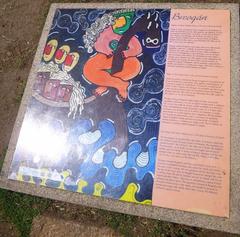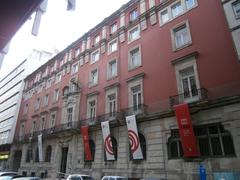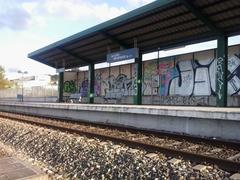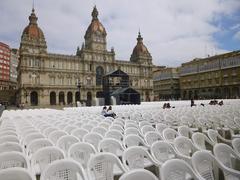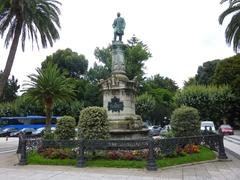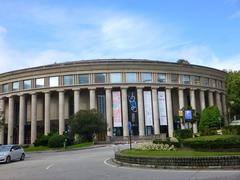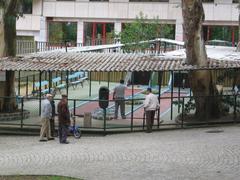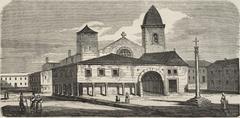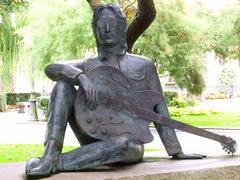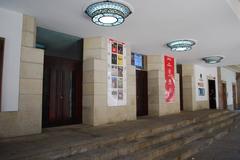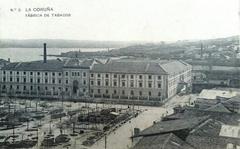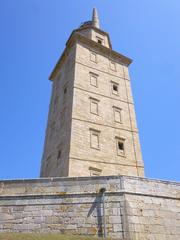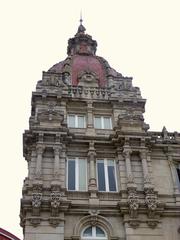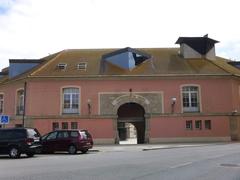
Xardín de San Carlos, A Coruña, Spain: Visiting Hours, Tickets, and Historical Sites Guide
Date: 03/07/2025
Introduction
Nestled in the heart of A Coruña’s Ciudad Vieja, the Xardín de San Carlos is a remarkable blend of medieval military heritage, romantic 19th-century landscaping, and urban ecological sanctuary. Originally constructed in the 14th century as a fortress guarding the city’s strategic port, the site is now best known for its tranquil garden setting, mature tree canopy, and the tomb of British General Sir John Moore—a poignant memorial to the city’s role in the Peninsular War and its enduring Anglo-Galician ties.
Over the centuries, the fortress evolved into a romantic garden, embracing ideals of reflection, memory, and natural beauty. Today, visitors encounter lush plantings, historic architecture, panoramic views of the port and Atlantic, and commemorative monuments. The garden is recognized as a Bien de Interés Cultural (BIC), underscoring its cultural, historical, and ecological significance.
This guide offers a detailed overview of Xardín de San Carlos: its history, key features, visitor information (including opening hours and accessibility), nearby attractions, and practical tips to enhance your visit. For more, consult official tourism resources and heritage portals (Turismo de Galicia, La Opinión A Coruña, A Coruña Tourism).
Table of Contents
- Introduction and Historical Context
- Evolution: From Fortress to Romantic Garden
- Key Features and Monuments
- Visitor Information
- Ecological Heritage and Conservation
- Nearby Attractions
- Frequently Asked Questions (FAQ)
- References
Historical Context: From Fortress to Garden
Medieval Origins and Military Heritage
The Xardín de San Carlos sits atop the site of the “Fortaleza Vieja,” a key 14th-century fortress safeguarding A Coruña’s port. Integrated into the city’s defensive perimeter as it expanded, the fortress witnessed dramatic episodes—most notably an explosion in 1658, when a gunpowder accident devastated the stronghold and nearby Convent of San Francisco. This tragedy, memorialized by annual processions for generations, underscores the site’s importance in local memory (Turismo de Galicia).
Transformation into a Romantic Garden
By the 19th century, as military needs faded, the site was reimagined as a romantic garden under Governor Don Francisco de Mazarredo. The garden’s meandering paths, mature elms, panoramic viewpoints, and tranquil ambiance reflect the era’s ideals—a harmonious blend of history, reflection, and nature. Remnants of the original fortress, including stone walls and parapets, remain integral to the site’s character (La Opinión A Coruña).
Key Features and Monuments
The Tomb of Sir John Moore
The centerpiece is the neoclassical tomb of Sir John Moore, a British general who fell during the 1809 Battle of Elviña. Moore’s leadership and sacrifice against Napoleonic forces are honored by a granite and marble monument, surrounded by iron railings and shaded by old elms. Inscriptions by the Duke of Wellington, poet Charles Wolfe, and Rosalía de Castro testify to his international and cultural legacy (Turismo de Galicia).
Memorial Plaques and Literary Inscriptions
Plaques and poetic inscriptions throughout the garden honor Moore, Galician soldiers, and the 172 British sailors lost in the 1890 HMS Serpent shipwreck. These commemorations deepen the site’s emotional and historical resonance (La Opinión A Coruña).
Architectural Setting
Thick stone walls, original fortress entrances, and lookout points frame the garden. The nearby Archivo del Reino de Galicia, housed in a stately historic building, complements the atmosphere and preserves centuries of regional records (Wikimedia Commons).
Visitor Information
Opening Hours
- April to September: 9:00 AM – 9:00 PM
- October to March: 9:00 AM – 7:00 PM
- Note: Hours may vary on public holidays or during restoration; check official tourism sites for updates.
Tickets & Admission
- Admission: Free year-round
Accessibility
- Wheelchair Access: Most paths are paved and accessible; some historic areas may have uneven surfaces.
- Seating: Benches throughout the garden.
- Restrooms: No public restrooms on-site; nearest facilities are in nearby museums or cafés.
Guided Tours and Events
- Guided Tours: Offered seasonally by the A Coruña tourism office and local guides; topics include history, architecture, and ecology.
- Events: Annual commemorations, especially on the anniversary of the Battle of Elviña (January 16), and occasional cultural activities.
Travel Tips
- Getting There: Located in the Old Town, a short walk from María Pita Square, the Archive of the Kingdom of Galicia, and Castillo de San Antón.
- Public Transport: Several city bus lines stop nearby; the garden is well signposted from central transit hubs.
- Parking: Limited in the Old Town—public transport or city parking lots recommended.
- Best Times to Visit: Spring and early summer for blooms; early mornings and late afternoons for quieter visits and best light for photography.
Ecological Heritage and Conservation
Mature Tree Canopy and Plantings
The garden is renowned for its centuries-old elms (Ulmus spp.), supplemented by laurels, plane trees, roses, and seasonal flowers. Despite its compact size, it supports a variety of birds and pollinators, serving as a crucial green oasis in the city (La Opinión A Coruña).
Conservation Efforts
- Restoration Projects: Major restorations in 2022 and 2025 addressed Dutch elm disease by replacing diseased trees with resistant varieties, restoring the original garden layout, and enhancing visitor facilities (Concello da Coruña).
- Heritage Status: Listed as a Bien de Interés Cultural (BIC) since 1944, ensuring the protection of its historical, architectural, and ecological values.
- Community Engagement: The garden is used for educational programs and local heritage initiatives.
Nearby Attractions
- Archive of the Kingdom of Galicia: Historic archives and exhibitions
- Castillo de San Antón: Seafront castle and archaeological museum
- Tower of Hercules: UNESCO World Heritage lighthouse
- Emilia Pardo Bazán House Museum: Literary heritage
- Casa Museo María Pita: Museum dedicated to the city’s legendary heroine
All are within walking distance, forming a rich cultural route through A Coruña’s historic core (A Coruña Tourism).
Frequently Asked Questions (FAQ)
Q: What are the opening hours of Xardín de San Carlos?
A: April–September, 9:00 AM–9:00 PM; October–March, 9:00 AM–7:00 PM (check official sites for updates).
Q: Is there an entrance fee?
A: No, admission is free.
Q: Are guided tours available?
A: Yes, seasonally through the tourism office or local guides.
Q: Is the garden wheelchair accessible?
A: Mostly, but some surfaces near the historic walls may be uneven.
Q: Are pets allowed?
A: Dogs on leashes are generally permitted—check current regulations.
Q: What is the best time to visit?
A: Spring and early summer for floral displays; early mornings and late afternoons are quieter.
Visuals
_01.jpg/800px-Xardin_de_San_Carlos_(A_Coruña)_01.jpg)

Summary and Next Steps
Xardín de San Carlos is a captivating emblem of A Coruña’s layered history and cultural richness, blending medieval military origins, romantic garden sensibilities, and ecological vitality. Free and accessible year-round, the garden invites visitors to discover poignant memorials, historic architecture, lush vegetation, and panoramic vistas. Ongoing restoration and conservation efforts ensure its legacy endures.
Plan your visit to coincide with spring or early summer for the best floral displays, and consider a guided tour for in-depth insights. For up-to-date information, download the Audiala app or consult the official tourism resources.
References
- Turismo de Galicia
- La Opinión A Coruña
- VisitCoruna – Xardín de San Carlos
- Concello da Coruña – Tree Restoration
- A Coruña Tourism
- Wikimedia Commons






